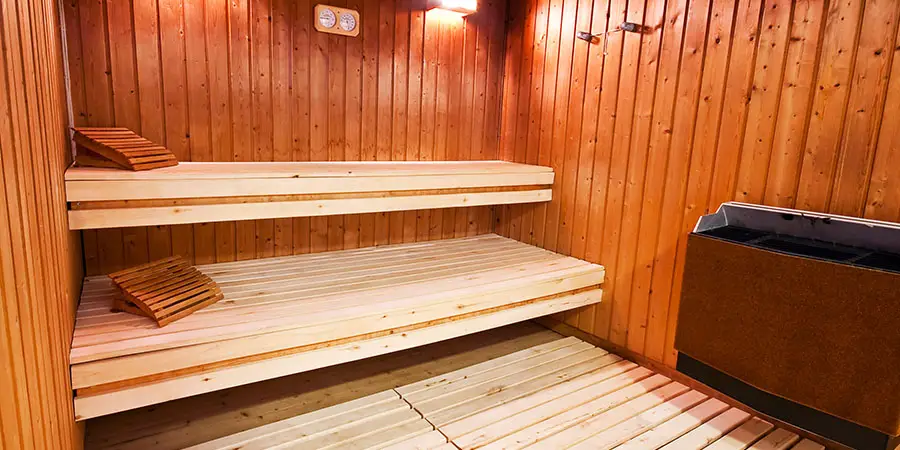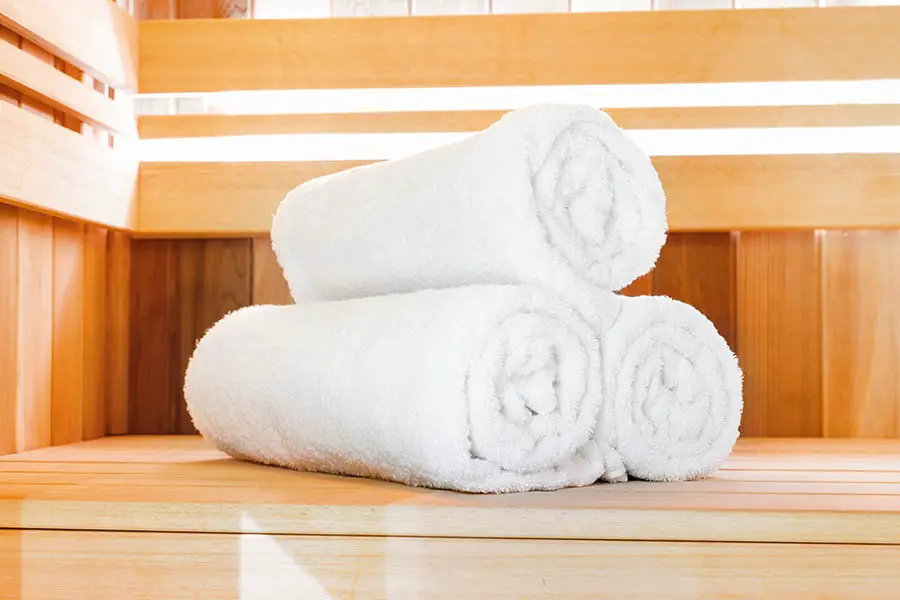Saunas have many health benefits that attract people to them. Chances are that if you’re about to enter a sauna, you know you’re going to sweat – it’s part of the experience. The temperature is typically between 150°F and 190°F, which is the best temperature to get your blood flowing and for you to sweat out toxins from deep within your body. However, if you’re new to saunas, you may be wondering about germs. Are saunas full of germs?
Saunas are warm and moist – two conditions in where bacteria can easily grow. People sweat in saunas, leaving behind their germs. A public sauna is much more likely to have germs and bacteria in it than a personal sauna, but all saunas should be cleaned regularly to prevent the growth of any bacteria.
Usually, even a public sauna is not that much of a worry because you’re going to wear a towel or have some other layer between you and the surfaces on which bacteria can grow. And oce you understand sauna etiquette around towel use and cleaning, you’ll be less concerned about germs and able to properly menjoy your session. If you plan on building your own sauna, know that a proper cleaning routine is a must to ensure fewer bacteria thrive.
Are Saunas Full of Germs?

Saunas can grow germs and bacteria very well due to their heat and moisture levels. For this reason, it’s important to keep them clean. This can be especially true for public saunas where a lot of people go in and out. The temperature is perfect for bacteria and microorganisms to breed and spread. If someone has a cold and goes into a sauna, for instance, they could leave behind body fluids that may spread that cold.
The air can also cause a person who already has some condition to start coughing more than usual, which further spreads germs. When you go into a communal sauna at the gym or spa, the sauna must have a way to circulate air, like a vent or valve. This will help keep germs to a minimum, because the air circulation will typically have a filtration system as well. This isn’t going to remove 100% of any airborne contaminents, but it will surely help.
There are steps you can take to minimize your exposure in a sauna as well, and we’ll cover those below, but in general, public saunas are not especially dirty. They can be, but the cleaning routine for that sauna really affects this outcome, and that will be different from facility to facility. A great way to consider the cleanliness of a public sauna is to simply poke your head in and survey the scene before you even change. If you see any stains on the seating, any mold in the corners, or if you smell any kind of funk at all, it may be better to skip it this time and mention to a manager on your way out that it needs to be cleaned.
Here Are Some Steps on How You Can Stay Safe in a Sauna:
If we’ve learned anything the last couple years it’s that people, while generally great, are sometimes very annoying as individuals. In the same way that other people might not wear a mask, increasing your risk, but you can wear one to fractionally increase your own safety, there are points of sauna etiquette that, though everyone should be following, may very from site to site. that said, if you follow these tips of sauna etiquette, it will shield you from the majority of bacteria and germs others may carelessly leave behind.
- First: Always sit on a towel to catch your sweat and provide a clean layer between you and the sauna seating.
- Wear flip flops, because the floor tends to be where the most germs are.
- Cover any injuries before your sauna visit.
- Have a quick shower both before and after your session.
If you follow all of these tips, you will ensure a safe visit to the sauna. If you have your own at-home sauna, you will want to maintain a good cleaning schedule. Your risk is a lot lower for spreading germs unless you have guests use it frequently. And if you do have guests over to enjoy your sauna, be sure to enforce strict sauna etiquette to keep your sauna clean!
What Infections Could Develop From The Sauna?
A few things are known to come from saunas and that you should be mindful of. None of them are life-threatening, and if you follow sauna etiquette, there are very slim chances of these happening to you. There is a chance of the following infections: a yeast infection on the skin, a fungal infection, impetigo, and a few other bacterial infections that are less common but still possible.
Are Steam Saunas More Conducive to the Spread of Bacteria?
Steam saunas do not get as hot as traditional saunas, so it is easier for bacteria to thrive in these conditions. You should always go to a steam sauna that practices proper cleaning protocols. This may be more of a risk. The steam rooms’ tiles do not have any antibacterial properties like the wood used in a traditional sauna.
Are Infrared Saunas More Conducive to the Spread of Bacteria?
Infrared saunas don’t have all the humidity floating around in the air, so this important ingredient for bacteria to thrive is thankfully missing. Without all that damp moisture that a steam sauna has, bacteria and mold are both less likely to grow. That said, people are still sweating a lot, and leaving their own fluids behind. So, while the likelihood of bacteria or germs being present in an infrared sauna is lower, it’s still not zero.
How to Stay Clean in The Sauna

One of the best ways to stay clean in the sauna is by dressing appropriately. You will want to go nude or in very loose-fitted clothing, with that all-important towel to serve as a layer between you and the actual sauna surfaces. Some items should be kept out of the sauna. If you own your own sauna, you will want to understand how to properly clean the wood and how often you need to do so. You should always sit on a towel and wear flip-flops meant for inside in a public sauna.
After you are done, you can take a sponge that most saunas have and gently wipe down where you were sitting. This assures the others that you are doing your part to maintain a clean sauna. If you are in your own sauna, you should always wipe it down after every use with a gentle sponge and water. To ensure the sauna airs out, leave the door open a crack. This will help eliminate any germs, cool it down, and ensure there will be no mold in the future.
Use High Temperature To Thwart The Spread Of Sauna Bacteria
Bacteria love moist and warm environments, but many microorganisms will die in high enough temperatures. You should always look for a sauna that is above 150°F. Most bacteria will die between 140°F and 158°F, so anything between those is perfect if you want to stay safe in the sauna. You will want to keep your eye on the hygrometer and thermometer in your sauna.
To properly clean out the bacteria, all you need to do is rinse off the floors, benches, and handles with soft soap and water. Then let the sauna continue to heat up the area for a few minutes. This will ensure the bacteria dies while it cools down. After this is done, you can leave the sauna door open to let everything air out. If you want to periodically heat-clean your sauna, you can set the temperature very high and walk away. This sort of treatment can kill any bacteria or germs that cleaning misses, using high heat. Just be careful to plan ahead and not burn yourself!
Although saunas can be breeding grounds for germs, they can easily be cleaned out. If you are sitting in a public sauna, you will want to ensure you wear the proper clothing, rinse off before and after the sauna, and sit on a towel to catch the sweat. If you feel comfortable, you should always wear flip-flops or foot covers because the floor tends to be the germiest. Having your own sauna means less risk, but you should still always clean regularly.


